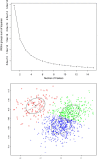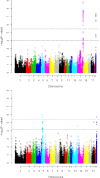Analysis of the genetics of boar taint reveals both single SNPs and regional effects
- PMID: 24894739
- PMCID: PMC4059876
- DOI: 10.1186/1471-2164-15-424
Analysis of the genetics of boar taint reveals both single SNPs and regional effects
Abstract
Background: Boar taint is an offensive urine or faecal-like odour, affecting the smell and taste of cooked pork from some mature non-castrated male pigs. Androstenone and skatole in fat are the molecules responsible. In most pig production systems, males, which are not required for breeding, are castrated shortly after birth to reduce the risk of boar taint. There is evidence for genetic variation in the predisposition to boar taint.A genome-wide association study (GWAS) was performed to identify loci with effects on boar taint. Five hundred Danish Landrace boars with high levels of skatole in fat (>0.3 μg/g), were each matched with a litter mate with low levels of skatole and measured for androstenone. DNA from these 1,000 non-castrated boars was genotyped using the Illumina PorcineSNP60 Beadchip. After quality control, tests for SNPs associated with boar taint were performed on 938 phenotyped individuals and 44,648 SNPs. Empirical significance thresholds were set by permutation (100,000). For androstenone, a 'regional heritability approach' combining information from multiple SNPs was used to estimate the genetic variation attributable to individual autosomes.
Results: A highly significant association was found between variation in skatole levels and SNPs within the CYP2E1 gene on chromosome 14 (SSC14), which encodes an enzyme involved in degradation of skatole. Nominal significance was found for effects on skatole associated with 4 other SNPs including a region of SSC6 reported previously. Genome-wide significance was found for an association between SNPs on SSC5 and androstenone levels and nominal significance for associations with SNPs on SSC13 and SSC17. The regional analyses confirmed large effects on SSC5 for androstenone and suggest that SSC5 explains 23% of the genetic variation in androstenone. The autosomal heritability analyses also suggest that there is a large effect associated with androstenone on SSC2, not detected using GWAS.
Conclusions: Significant SNP associations were found for skatole on SSC14 and for androstenone on SSC5 in Landrace pigs. The study agrees with evidence that the CYP2E1 gene has effects on skatole breakdown in the liver. Autosomal heritability estimates can uncover clusters of smaller genetic effects that individually do not exceed the threshold for GWAS significance.
Figures






Similar articles
-
Genomic background and genetic relationships between boar taint and fertility traits in German Landrace and Large White.BMC Genet. 2020 Jun 8;21(1):61. doi: 10.1186/s12863-020-00865-z. BMC Genet. 2020. PMID: 32513168 Free PMC article.
-
Genetic parameters for androstenone and skatole as indicators of boar taint and their relationship to production and litter size traits in Danish Landrace.J Anim Sci. 2013 Jun;91(6):2587-95. doi: 10.2527/jas.2012-6107. Epub 2013 Mar 18. J Anim Sci. 2013. PMID: 23508028
-
Association between SNPs within candidate genes and compounds related to boar taint and reproduction.BMC Genet. 2009 Jul 5;10:32. doi: 10.1186/1471-2156-10-32. BMC Genet. 2009. PMID: 19575819 Free PMC article.
-
Recent genetic advances on boar taint reduction as an alternative to castration: a review.J Appl Genet. 2021 Feb;62(1):137-150. doi: 10.1007/s13353-020-00598-w. Epub 2021 Jan 6. J Appl Genet. 2021. PMID: 33405214 Free PMC article. Review.
-
Consumer studies on sensory acceptability of boar taint: a review.Meat Sci. 2012 Dec;92(4):319-29. doi: 10.1016/j.meatsci.2012.05.009. Epub 2012 May 24. Meat Sci. 2012. PMID: 22682684 Review.
Cited by
-
Genomic background and genetic relationships between boar taint and fertility traits in German Landrace and Large White.BMC Genet. 2020 Jun 8;21(1):61. doi: 10.1186/s12863-020-00865-z. BMC Genet. 2020. PMID: 32513168 Free PMC article.
-
Genomic Prediction and Genome-Wide Association Study for Boar Taint Compounds.Animals (Basel). 2023 Jul 28;13(15):2450. doi: 10.3390/ani13152450. Animals (Basel). 2023. PMID: 37570259 Free PMC article.
-
Efficiency of genomic prediction for boar taint reduction in Danish Landrace pigs.Anim Genet. 2015 Dec;46(6):607-16. doi: 10.1111/age.12369. Epub 2015 Oct 9. Anim Genet. 2015. PMID: 26449733 Free PMC article.
-
Multi-omic data integration and analysis using systems genomics approaches: methods and applications in animal production, health and welfare.Genet Sel Evol. 2016 Apr 29;48(1):38. doi: 10.1186/s12711-016-0217-x. Genet Sel Evol. 2016. PMID: 27130220 Free PMC article. Review.
-
Systems genomics study reveals expression quantitative trait loci, regulator genes and pathways associated with boar taint in pigs.PLoS One. 2018 Feb 13;13(2):e0192673. doi: 10.1371/journal.pone.0192673. eCollection 2018. PLoS One. 2018. PMID: 29438444 Free PMC article.
References
-
- Patterson RLS. 5α-androst-16-en-3-one: compound responsible for taint in boar fat. J Sci Food Agric. 1968;19:31–38. doi: 10.1002/jsfa.2740190107. - DOI
-
- Desmoulin B, Bonneau M, Frouin A, Bidard JP. Consumer testing of pork and processed meat from boars: the influence of fat androstenone level. Livest Prod Sci. 1982;9:707–715. doi: 10.1016/0301-6226(82)90018-5. - DOI
-
- Walstra P, Claudi-Magnussen C, Chevillon P, Von Seth G, Diestre A, Matthews KR, Homer DB, Bonneau M. An international study on the importance of androstenone and skatole for boar taint: levels of androstenone and skatole by country and season. Livest Prod Sci. 1999;62:15–28. doi: 10.1016/S0301-6226(99)00054-8. - DOI
-
- Malmfors B, Lundstrom K. Consumer reactions to boar taint – a review. Livest Prod Sci. 1983;10:187–196. doi: 10.1016/0301-6226(83)90034-9. - DOI
-
- Bonneau M, LeDenmat M, Vaudelet JC, Nunes JRV, Mortensen AB, Mortensen HP. Contributions of fat androstenone and skatole to boar taint: I. Sensory attributes of fat and pork meat. Livest Prod Sci. 1992;32:63–80. doi: 10.1016/S0301-6226(12)80012-1. - DOI
Publication types
MeSH terms
Substances
Grants and funding
- BBS/E/D/20211553/BB_/Biotechnology and Biological Sciences Research Council/United Kingdom
- BBS/E/R/00001615/BB_/Biotechnology and Biological Sciences Research Council/United Kingdom
- MC_PC_U127592696/MRC_/Medical Research Council/United Kingdom
- BBS/E/R/00001606/BB_/Biotechnology and Biological Sciences Research Council/United Kingdom
- BBS/E/D/05191132/BB_/Biotechnology and Biological Sciences Research Council/United Kingdom
LinkOut - more resources
Full Text Sources
Other Literature Sources
Molecular Biology Databases

